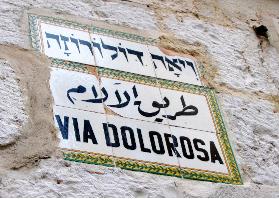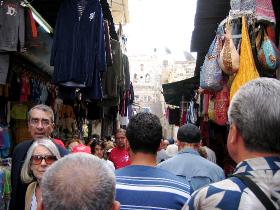 |
|
Israel Journal COLLEEN TINKER |
||||
NUMBER 13 — SATURDAY, NOVEMBER 8, 2008
Walking in Jerusalem: Via Dolorosa, Pool of Bethesda, and Shrine of the Book
Shabbat (Sabbath) is over in Jerusalem for another week. As I write those words, I realize how NEW, how amazing it is that we literally live in unending Sabbath rest now. That week-to-week seeking after something “special” is so exhausting and discouraging. Wow—to be free of the never-successful attempts to honor God on the Sabbath—to be free of that special-remnant-tie that bound us together because we didn’t quite fit anywhere else, nor did non-Adventists fit with us is such a relief!
Today began with our 6:10 AM walk back to the Western Wall. The sun was just rising, and the streets that had been full of noise and merchants and smells and running people were quiet. I discovered I’d been wrong in part of my explanation of the Muslim sector last night. Cars DO go down those old stone-paved streets—but we didn’t actually encounter any last night because the streets were too full of people. This morning, however, we moved aside for a few vehicles that were bringing in supplies for the day’s marketing. For sure, however, only one car at a time can move down the street at any one spot—and we didn’t meet many.
Another detail I’d missed was that parts of the market place were not under roofs. The narrow streets run between tall, multi-storied buildings in many places with narrow aisles of sky above the worn stones. In the daylight the portions open to the sky are far more visible than at night. To be sure, however, much of the marketplace is under vaulted ceilings over which there are apartments or businesses.
At the West Wall, despite the early hour, many people were praying—not as many as the night before--but a large number. This morning a large percentage of the men were wearing prayer shawls, something missing from last night. Perhaps that’s a morning prayer characteristic…?
Our first official stop this morning was at the Museum of Jewish History. It exists inside an old Crusader fortress built on top of a Byzantine fortress built on top of a portion of Herod the Great’s palace. While the exact location is debated, Gary says many scholars are quite sure (he falls into this camp) that Pilate’s inquisition of Jesus likely happened at this place. Here we walked through a history of the Jews including the various political occupations of the land, and I finally began to formulate a mental “picture” explaining why there are so many Byzantine churches and Crusader fortresses and Ottoman buildings in the layers under the visible city.
Indeed, since AD 70 until 1948 the land had not been under any Jewish control. The Jews’ dispersion after rejecting the Messiah had been complete. Yet even in the existence of a secular Jewish state, we see God’s faithfulness at work as He continues to fulfill His promises to Israel in His own time and way.
Pool of Bethesda
After our tour through the Jewish History Museum we went to the gate into the Old City known as the Lion’s Gate.Inside we visited St Anne’s church which was built beside the excavation of the pool of Bethesda. Inside the church Michael and Janice Hicks sang "The Via Dolorosa".
The pools were astonishing. Excavation is continuing, but in some places it has gone to a depth where the stones date from the third to the seventh centuries BC. The pools are very large compared to my mental image of them, and they had been built to accommodate large numbers of people.
This is the place where, on the Sabbath, Jesus encountered the crippled man who was not able to get into the water. Apparently an ancient tradition said that there were curative properties in the water and that an angel would periodically stir up the waters during which time bathers would be healed of their diseases. Jesus, however, simply asked this one man if he wanted to be well.
When the man said he did, Jesus told him to pick up his bed and walk. This is one of His Sabbath miracles by which He demonstrated that He was the Messiah, not only causing the lame to walk, but by breaking the Sabbath by healing and by commanding the man to break the Sabbath by carrying His bed.
Further, Jesus encountered this same man a bit later in the temple (where the man was lawfully required to go to offer thanks for God’s intervention). In spite of Jesus’ warnings to this man not to tell who He was, the man’s healing was obvious, and he was not afraid to identify Jesus to the priests when they asked who had healed him. The priests were outraged, and they confronted Jesus. Yet he replied that His Father was working, and He also was working.
His use of “Father” was unprecedented in Palestinian Judaism. Jews called God “God”, even using “code” words so as not to pronounce His holy name. Yet Jesus was claiming identity with God, and the priests anger was intensified because not only was He breaking the Sabbath with His miracles, but He was calling Himself God by identifying Himself as His Son.
Via Dolorosa
When we left the church and pool we began our walk on the Via Dolorosa. Here we experienced in daylight the crush of Muslim markets we had passed through the night before. In the daytime, however, the crowds were even worse. Not only were there Muslims operating their tiny shops which spilled out the fronts of their cubicles, but thousands of visitors also plied the streets, straining to walk the traditional walk thought to be the way Jesus went on His way to the cross.
I have never experienced such masses of people. Richard has been in charge of helping a lady who is not from our congregation who is on this trip. She is quite disabled with arthritis, and she has had to make her way on this trip with a walker and a wheelchair. Yesterday’s walk up the Via Dolorosa had to be done in a wheelchair; it was much too far and too difficult for her to make it on her own. Fortunately there were several men who assisted as they came to the many steps along the way, lifting the front end of the chair as Richard pushed from behind.
The atmosphere was as far from “church” or “worship” as could be imagined. Rather, it seemed more like a giant carnival or a great fair. We’ve learned that Americans’ sense of personal “space” is different from that of people from the middle East. They think nothing of pushing, standing close, and speaking if they want something. We walked through the crowds, progressing slowly, our senses over-stimulated by unfamiliar sights, sounds, and smells.
Between an hour-and-a-half and two hours after commencing our trek, we stopped for lunch in the Christian sector. There a restaurant was expecting us, and they served falafels to all 66 of us. After a break during which our group ate and browsed through shops in the area, we continued the remainder of the walk, finally reaching the Church of the Holy Sepulcher.
This church was worth seeing, but it was horrifying at the same time. It has been internally divided between the Orthodox, Catholic, Coptic, Ethiopian, and Armenian churches with each claiming certain chapels and relics as their “own”. The issue with claiming “space”, however, is that whoever claims to “own” the space is responsible for maintaining that space. The crowds inside that church were nearly as un-navigable as was the Via Dolorosa.
We were given a short period to see inside before meeting in the outer courtyard. Just as we were making our way to the door, the great outer door was shut, and the Armenian priests began queuing up for a processional. We looked for an alternate way out but could find none. We were “trapped” in the Church of the sepulcher!
Richard found a man dressed as a priest from one of the represented churches and asked him about a way out. He told Richard that the procession would last an hour, and he said the only way out was to simply push against the people and gradually work our way toward the front door.
By this time the procession was moving, the priests passed in black robes with black pointed hoods over their heads as they chanted. We and the others from our group also “trapped” began pushing toward the door, and we finally found that it had been opened after the procession had moved away from it.
While it is likely that Jesus’ crucifixion and entombment happened near that church, the church itself was actually rather horrifying. It was all about icons and grasping for “territory”. It felt commercial and dark, and I realized after we left that it had felt very pagan to me. The innumerable people who had been lined up for the chance to complete their pilgrimages by kissing the spots or the supposed relics represented by each chapel seemed deceived and blinded as people who pay homage to man-made gods. It was actually sad—these people all claimed to be Christians, yet they were mostly not rejoicing in a risen Savior whose work is done but were hoping to gain grace by honoring the relics of His suffering.
Shrine of the Book
We ended the day at the Shrine of the Book where the Dead Sea scrolls are housed. Outside is a huge replica of Jerusalem showing its gates from the time of the second temple to the time of Herod’s temple. This model has been built on the basis of years of detailed excavation and research. As we looked at the model of the temple (which dominated the entire city), Gary reminded us that the ENTIRE temple spoke of God’s holiness and grandeur.
When Jesus died, the veil tore. That veil had represented holiness and separation from the glory of God. The tearing represented access to God, and the veil itself represented Christ’s body.
Inside the museum we were able to see on display many of the fragments of the scrolls found in 1947 by that Bedouin boy who accidentally broke a clay pot with a rock. I am amazed how God has preserved His word, kept His promises, and has, in His own time, confirmed Himself and His faithfulness. No matter how sophisticated the scholars, they have not been able to disprove or deny the reality of God’s sovereign care, protection, and faithfulness to Himself, His word, and His people—of whom we are a part!
We ended the day with an optional trip to a program of Jewish and Arab folk dances and songs held at the local YMCA. The dance troupe was a group of young adults who were very good, and the evening’s hostess was a young woman with a lovely voice who sang Israeli folk songs. It was a well-done program, but many among us were so tired they slept through part of it.
Today we go to the temple mount and the Garden Tomb. I will update you later…it’s hard to believe we’ve seen all we’ve seen and that our trip is nearly over.
Copyright 1999-2008 Graphics Studio, Redlands, CA USA. All rights reserved. Revised November 17, 2008. Use of this site and forum signifies your acceptance of the Terms and Conditions. Send comments and questions to formeradventist@gmail.com
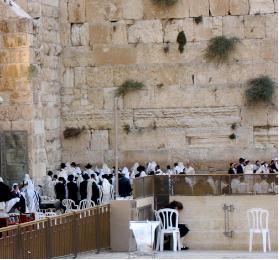
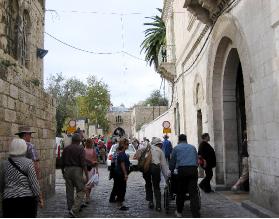


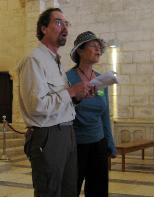
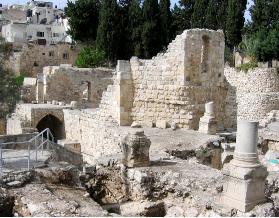 The Pool of Bethesda where Jesus healed the crippled man on Sabbath.
The Pool of Bethesda where Jesus healed the crippled man on Sabbath. 